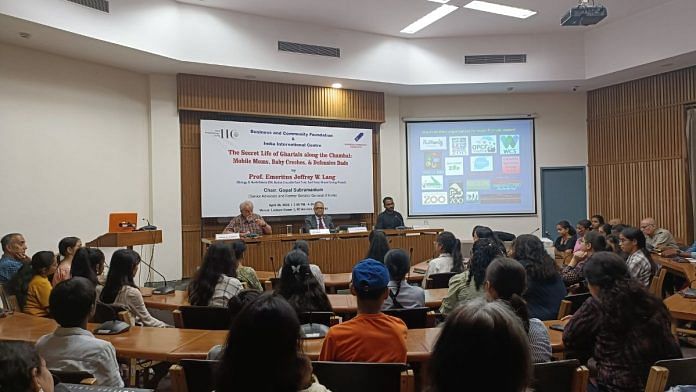New Delhi: The gharials in Madhya Pradesh’s Chambal river were dying, and nobody could figure out why. As many as 110 Asiatic crocodilians were found dead, 80 kilometres upstream of the Yamuna. All of them were sub-adults barely two to three metres in length. That was back in 2008.
The deaths rocked the conservation world and spurred a massive effort to save the world’s only functional wild population of gharials. From that tragedy emerged an international task force and the birth of the Gharial Ecology Project. It was led by Romulus Whitaker, the famous ‘Snakeman of India’ and founder of the Madras Crocodile Bank Trust, Dhruva Jyoti Basu of World Wildlife Fund – India, and Jeffrey Lang, professor of biology at the University of North Dakota in the United States.
While living in second-hand tents on local villagers’ terraces, they started the seminal ‘Gharial Ecology Project’ in 2008 near the Chambal River—a project that is now in its 16th year.
“We wanted to know exactly how the toxins affected the animals, and why only a particular age group,” said Lang at a recent talk on the Gharial Ecology Project in New Delhi’s India International Centre. He explained the motivation behind their one-of-a-kind research and conservation initiative at Chambal.
“To help people understand, I would always say that gharials are the tigers of the aquatic world – since people are only focused on conserving tigers,” Lang added.
Fuelled by the mysterious deaths of these gharials, the Gharial Ecology Project became a frontrunner in gharial research and conservation efforts and now has patrons such as the Berlin Zoo, Prague Zoo and other international organisations.
How the gharials died
After spending 16 years researching gharial habitats and behaviours, Jeffrey Lang and his team weren’t convinced by the explanation for their mass deaths in 2008. Given how little was known about gharial biology back then, their sudden death was a mystery to even the Ministry of Environment, Forests and Climate Change, which is why they determined that the reptiles had died after travelling to and being exposed to the polluted water of the Yamuna, of which the Chambal River is a tributary.
However, the Gharial Ecology Project found that the reptiles, most of them sub-adults, were exposed to toxins in a stretch of the Chambal itself – much higher upstream than initially thought. They came to this conclusion after discovering through their monitoring that sub-adult gharials were quite restricted in their movement. Therefore, the source of the toxins that killed them had to be within a 15-kilometre range of where their bodies were later found.
Lang and the Madras Crocodile Bank Trust carried out their investigation by radio-tagging and monitoring 30 gharials. They hoped to understand their movement, get better insight into what caused their deaths, and come up with ways to prevent such incidents in the future.
Using pictures and vivid anecdotes, Lang described to an audience composed mainly of college and school-going students how his team established their field research at the National Chambal Sanctuary.
He explained how difficult it was for the Gharial Ecology Project to get geotagging permissions – they had to go back and forth between three state governments before finally getting the permits they needed.
However, they were helped every step of the way by the local communities near Chambal, in the villages of Uttar Pradesh and Rajasthan where they set up field sites. Lang joked about “the famous Indian hospitality”, and how his team would go through “20 kgs of atta (wheat flour) every few days” at their hosts’ house because of the delicious rotis they would make.
After geo-tagging the gharials, Lang and his team stumbled upon a whole world of information about gharial behaviour and potential reasons for the mass die-off event in 2008. It is important to note, explained Lang, that before they started the Gharial Ecology Project, the only information about gharials was recorded either in captivity or from sparse anecdotal notes.
“We found female gharials were more mobile, male gharials were usually tasked with protecting the eggs, and most importantly – sub-adult or teenage gharials were quite restricted in their movement around the river and tended to stay within a small stretch,” explained Lang.
As most of the deaths occurred among sub-adult gharials who do not move around too much, the source of the toxins that caused their deaths must be much closer to the location of the deaths, determined Lang. “We needed to find the source so that we prevent such a disaster from happening again.”
Toward the end of his talk, Lang expanded on how the project worked with local Chambal communities to reduce floodplain cultivation, curb sand mining as well as illegal fishing around gharial breeding grounds.
“There’s hopefully no mass death episode like the one in 2008, but we’re always looking to expand our efforts at conserving the ecology and wildlife at Chambal,” said Lang. “Our best audience and biggest hope is from students like you.”
(Edited by Zoya Bhatti)




He is just repeating one line like “most of them are teenagers and with restricted movements”. Literally repeating this numerous times made this article so long without any conclusion. Very pathetic article, school students can write better than this.
What nonsense is this. Where it is me turned they cracked it. This so called journalists is Crack and should be fired
Bumkum article